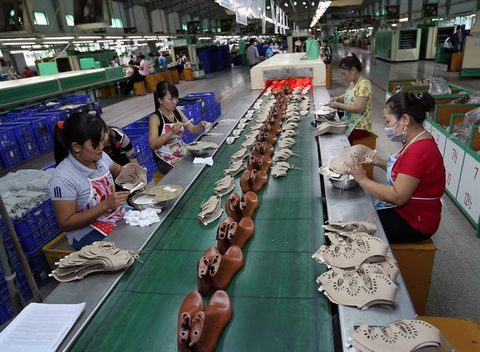VN footwear makers unfazed by TPP demise
 |
| Viet Nam’s leather and footwear industry will maintain its strong growth even if the TPP does not materialise, the Viet Nam Leather, Footwear and Handbag Association (Lefaso) has said.-VNA/VNS Photo Vu Sinh |
Speaking at the two-day 2017 Viet Nam Footwear Summit which opened in HCM City yesterday, Diep Thanh Kiet, Lefaso’s deputy chairman, said the industry enjoyed annual growth of 15-20 per cent in 2011-15.
Leather and footwear products were exported to nearly 50 countries and territories with the US, EU, China and Japan being the biggest markets.
The industry is fairly competitive thanks to the country’s economic, political and social stability and abundant supply of cheap and highly-skilled labour, he said.
Viet Nam has established a firm position among exporters to the US, being the second largest footwear exporter to that market, with its exports increasing year after year.
“The industry stands on three legs, with the US accounting for 34.5 per cent of its total exports, the EU for 31.9 per cent and other markets for the rest.”
Free trade agreements with the Republic of Korea, the Customs Union of Russia, Kazakhstan and Belarus, in addition to an agreement with the EU to take effect in future, are opening new windows for Viet Nam’s leather and footwear industry, he said.
The Government would continue to negotiate new FTAs to enable more exports of Vietnamese products, including footwear, he said.
“The health of the US economy is the determinant factor, not the TPP.”
If the TPP is signed but the US economy is not in good health, then demand would be not that good, he said.
But without the TPP, Viet Nam can still maintain its competitiveness and keep its second position in the US market, he said.
Matt Priest, president of the Footwear Distributors and Retailers of America, said the US imported 2.3 billion pairs of footwear last year.
China accounted for 72 per cent of the total and Viet Nam for 15.7 per cent, but China’s share is declining and Viet Nam’s is increasing, he said.
Phan Chi Dung, head of the Ministry of Industry and Trade’s light industry department, said domestic supply of tanned leather and other raw materials needed by the industry has increased to 40-50 per cent.
The world market is showing signs of recovery, while production costs in China, the world’s largest footwear supplier, have tended to increase in recent years, resulting in importers shifting orders to Viet Nam, he said.
Master plan
Talking about the industry’s development plans, Dung said it targets rapid, sustainable development and better use of free trade agreements to expand exports.
It plans to restructure production to add value to products, increase local content in products, improve designs, and focus on medium- and high-quality products for domestic and export markets, he said.
Delegates at the summit said Viet Nam’s leather and footwear sector has realised its weaknesses and is working to increase domestic content to meet the strict rules of origin enshrined in the trade agreements the country has signed.
Dung said the ministry is compiling a master plan for leather and footwear development, and it envisages production of more than 2 billion pairs of shoes a year by 2025, two times last year’s volume, and exports of over $30 billion.
“Demand for raw materials would also surge two or three fold, and so if the supporting industry is not developed in the coming years, the industry would have to depend greatly on imports, which would make it hard to accomplish its targets,” he said.
He urged footwear firms to join hands and to increase investment in modern equipment and technologies to capitalise on the opportunities brought by global integration, participate in the global supply chain and make Viet Nam a global footwear production base.
Phillip Kimmel of Kingmaker Footwear Holdings., Ltd said footwear firms should try to better understand current fashion needs, trends and directions.
They should recognise that footwear is a fashion business and that fashion changes periodically.
“In order to be a factory for the future, facilities must upgrade production machinery. Using tools like computer stitching machines enable factories to produce consistent, high-quality goods that add value to branded merchandise.”
In many cases, the proper use of automation can eliminate redundant workers and make factories much more efficient and profitable, he said.
There are some 1,700 enterprises in the sector in Viet Nam, of which 800 are large. Foreign-invested enterprises account for 80 per cent of the sector’s exports.
Leather and footwear products are among Viet Nam’s key export items, with exports reaching $16.2 billion last year, accounting for 10 per cent of the country’s total exports.
They are expected to top $17.88 billion this year.
The country is the third largest footwear maker and second largest exporter in the world.
What the stars mean:
★ Poor ★ ★ Promising ★★★ Good ★★★★ Very good ★★★★★ Exceptional
Latest News
More News
- Businesses ramp up production as year-end orders surge (December 30, 2025 | 10:05)
- Vietjet chairwoman awarded Labour Hero title (December 29, 2025 | 13:06)
- How to unlock ESG value through green innovation (December 29, 2025 | 10:03)
- AI reshapes media and advertising industry (December 29, 2025 | 08:33)
- FPT and GELEX sign deal to develop blockchain tech for global markets (December 29, 2025 | 08:29)
- Vietnam’s GDP forecast to grow by 9 per cent in 2026 (December 29, 2025 | 08:29)
- Women entrepreneurs are key to Vietnam’s economic growth (December 29, 2025 | 08:00)
- Vietnam's top 500 value-creating enterprises announced (December 27, 2025 | 08:00)
- The PAN Group shaping a better future with ESG strategy (December 26, 2025 | 09:00)
- Masan Consumer officially lists on HSX, marking the next phase of value creation (December 25, 2025 | 13:20)

















 Mobile Version
Mobile Version